Chitting Potatoes Gives Them a Head Start
This post may contain affiliate links, which means that I may receive a commission if you make a purchase using these links. As an Amazon Associate I earn from qualifying purchases.
Chitting potatoes is also called greensprouting, or pre-sprouting. Chitting it is a way of preparing potatoes for planting by encouraging them to sprout before planting in the ground. This gives the tubers a head start and encourages faster growth and heavier crops once the seed potatoes are planted.
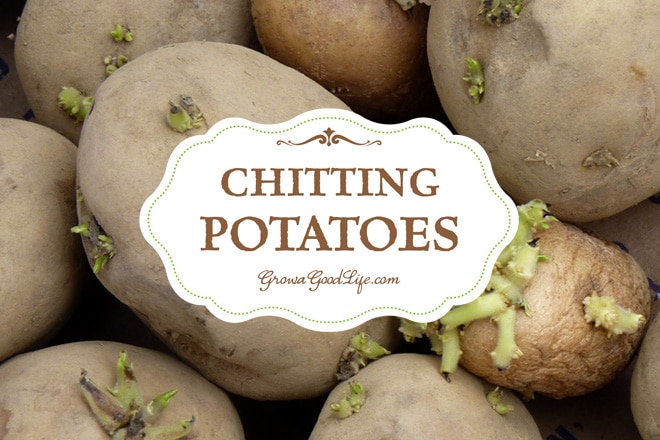
Seed potatoes are small potato tubers that you can purchase online or at your favorite garden or farm store. When you plant seed potatoes, you are planting a potato produced by the plant the previous year.
The process of chitting potatoes is simply encouraging the potato seeds to begin growing before they are planted into the ground.
Chitting potatoes is not a necessary step to growing potatoes, but it may give the crop a head start so it matures quicker.
How to Chit Potatoes
Once you have sourced your seed potatoes, and figured out your planting time, you can begin to chit or green sprout the potato seeds:
Step 1: Determine Your Potato Planting Time
Plan on planting your potatoes in early spring about two to four weeks before your last expected frost date. Look yours up by zip code at Plantmaps.com.
Step 2: Start Chitting Potatoes 4 Weeks Before Planting
Begin chitting potato seeds about 4 weeks before planting them in the ground.
Examine each potato and identify the end with the most eyes. This is called the rose end and this is where your potatoes will grow sprouts. Place your seed potatoes a single layer in egg cartons or shallow, open boxes with the rose end up.
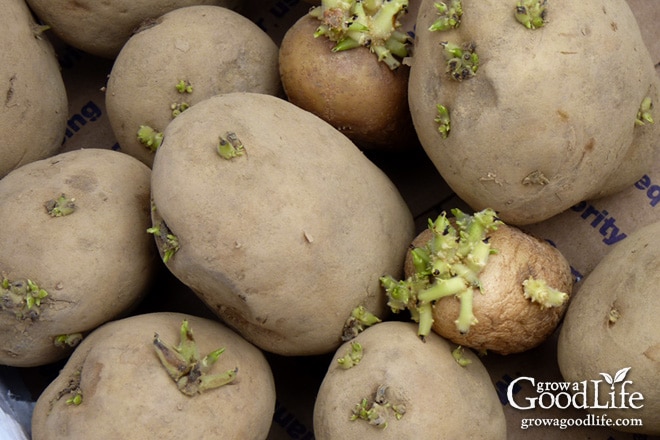
Step 3: Trigger the Potatoes to Sprout
Locate the seed potatoes in a warm dark area, around 70˚F (21˚C) to break their dormancy. You should see some sprouts a week or so.
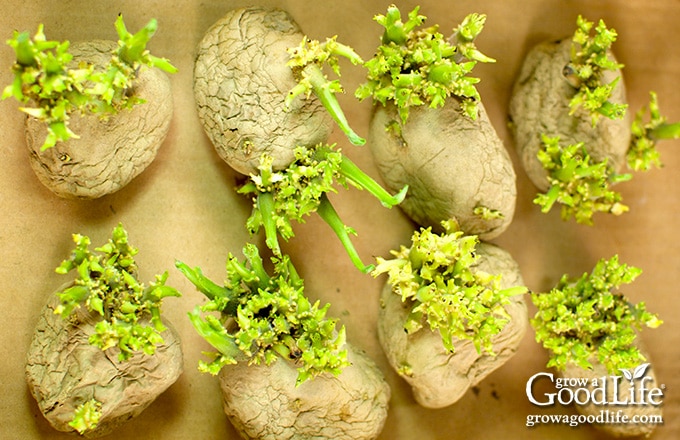
In about two weeks, move them to a cooler location 50˚F (10˚C) with some light. The light makes the sprouts turn green and healthy.
After about three weeks, you should see some nice green sprouts or pink depending on the potato variety. Let these sprouts grow until they are 1-2 inches (3-5 cm) long.
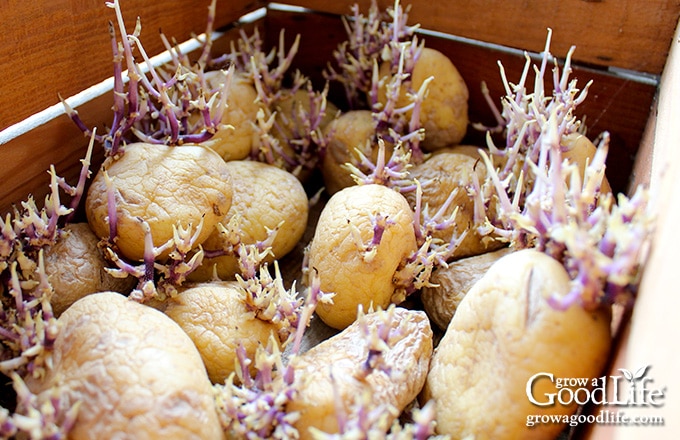
Step 4: Divide the Seed Potatoes for Planting
If your seed potatoes are large, you can divide them into smaller pieces. Cutting your seed potatoes is a thrifty way of increasing your seed stock and potential yield. Each piece will grow a potato plant that will produce numerous tubers.
Select egg sized segments with at least three sprouts per piece and cut the potatoes with a sharp knife. Let the cut areas heal over for a few days before planting. They should feel leathery and dry to the touch. You can also dip the freshly cut ends in in wood ash.
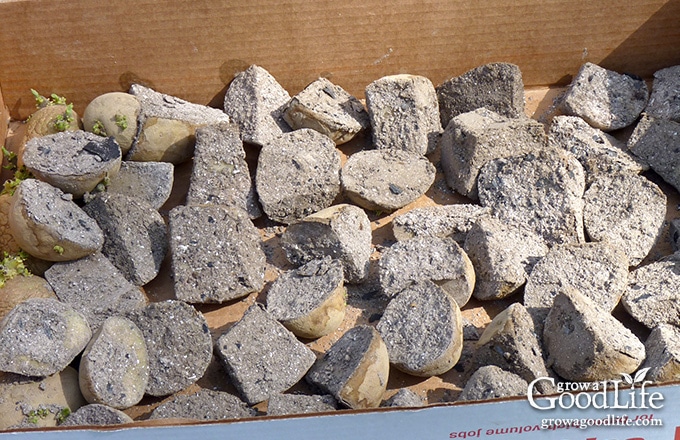
Plant the sprouted potatoes two to four weeks before your last expected frost date, once the soil has drained, and the soil temperature is at least 45˚F.
If you have to postpone planting because of the weather, move the seed potatoes to a cooler location to slow down the growth of the sprouts.
Want to Learn How to Grow Potatoes?
You will find everything you need to start growing potatoes in my PDF eBook, Grow a Good Life Guide to Growing Potatoes. Whether you are striving for a few gourmet fingerling potatoes or a large crop for winter food storage, this guide will show how you can grow your own, organic, homegrown potatoes.
Read On for More Potato Growing Tips:
- Sourcing Seed Potatoes for the Backyard Garden
- 8 Great Tips for Growing Potatoes
- 6 Different Ways of Growing Potatoes
- 5 Steps to Storing Potatoes for Winter
No matter how you plant your potatoes, chitting potatoes before planting can give your plants a few weeks head start and increase yield.
Good planning is key to a successful vegetable garden
Whether you are new to growing your own food or have been growing a vegetable garden for years, you will benefit from some planning each year. You will find everything you need to organize and plan your vegetable garden in my PDF eBook, Grow a Good Life Guide to Planning Your Vegetable Garden.
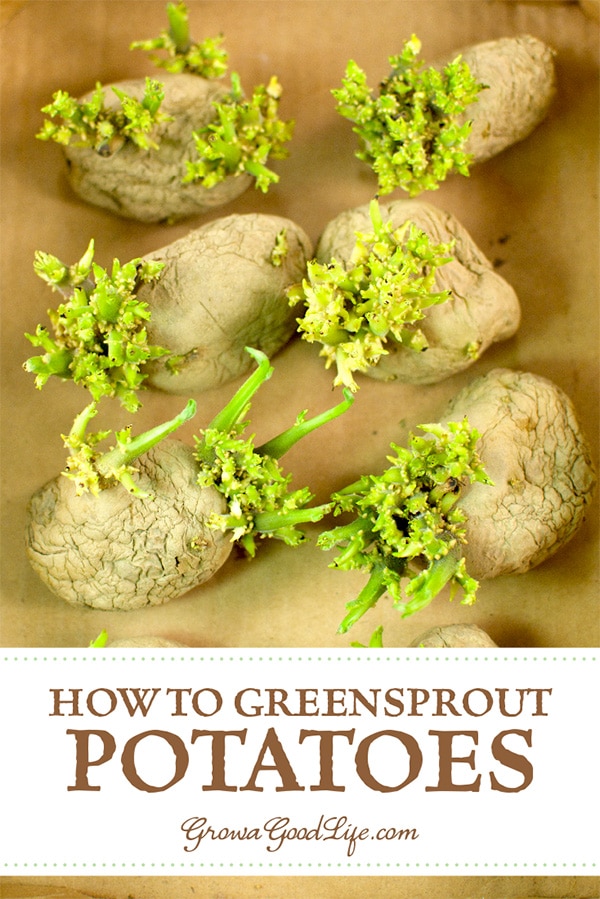


Finding a sunny, 50 degree location is a challenge.
Kevin, You don’t need sun, just daylight. To break dormancy, maintain a warm temperature of around 70°F (21°C) in a dark area to encourage sprouting. Once you see sprouts, move them to a cooler location with some indirect light at around 50°F (10°C) for healthy green sprouts. So, prioritize the temperature and light exposure, whether it’s natural or artificial, for successful potato chitting.
What if the potato has a very long sprout. Do you coil it around the potato or remove it?
Sandra, Bury the sprout as best as you can. You can even dig a trench and lay the sprout horizontal if it is very long.
First off, thank you — your article was very thorough. However, our NC Extension Service says to keep the seed potatoes in a warm, sunny location to help the sprouts grow (chitting) but your advice indicates a warm, dark location. Sometimes, this is the problem with the internet … which instructions does one follow? For a potato newbie, it’s very confusing. I have to believe that the way you are instructing is the way you’ve done your potatoes in the past and have had success with this method, whereas this is my first year at attempting a potato crop from seed potatoes and obviously, I want it to be a success, too. Your thoughts would be appreciated.
Kathy, In the article, I suggested breaking dormancy in a dark area and then introducing the potatoes to light as the sprouts develop so they green up. However, either way will work ok. One of the greatest things about the internet is everyone can share his or her experiences and you get to experiment to find out what works for you.
Need planting info: Are these sprouts roots or stems, so… do I plant them facing up or down? If roots, hoe deep. If stem, do I leave green parts above ground and will frost kill them, or how deep do I burry them to protect them from frost for 1 month?
Mike, I have linked to several articles on growing potatoes above under, “Read on for more potato growing tips.” These will provide more growing information. The sprouts are stems, and you plant them face up. Potatoes can be planted in early spring as soon as the ground can be worked, and once the soil temperature reaches 45˚F. Frost will damage the leaves and shoots, but if the seed potato is below the frost line, it will be insulated from damage.
After you cut the potatoes in sections and dip them in wood ash how long do you have to wait to plant or can you plant right away.
Cathy, Give it a day or two to callus over before planting.
I have tried planting seed potatoes before. I have been cutting my pieces too small. I have been only leaving 1 eye on the cutting & not letting them heal over. I have been loosing a lot of the cuttings as they are probably drying out too quickly in the ground. Rubbing them with wood ashes is a very interesting idea that I would never have thought of. This I will try this year, thank’s. We are having a very cold, snowy, wet spring so far this spring. Our ground is very wet in the spring anyway so this weather is going to be a challenge planting a garden at all
I’ve planted several potatoes over the years, plain old commercial sold in the grocery story potatoes. I don’t think any have failed to produce. I just wait to see sprouts in the pantry and save those for the garden. It’s been fun gathering the little spuds. They don’t get very large either because I harvest too soon, or I don’t do much prep or tending. But it’s a fun little activity for the kids.
Mary, It IS fun and small potatoes are so tasty.
THIS!! Thanks for this. I’ve been wondering what the difference is between the eyes on my forlorn lost-in-the-pantry- potatoes and garden center “seed” potatoes. If the former works, I’m about to get busy with potato gardening. Thanks!
This was an interesting read! Is this what happens when pototoes “go bad’ and start sprouting in the kitchen?
Vanessa, Yes, if your kitchen potatoes are organic, you can plant them when they sprout. Some potatoes from the grocery store are sprayed with a sprout inhibitor that will discourage the plant to grow.
This is the first year that I’ve saved seed potatoes & have been only somewhat successful – the potatoes that I set aside for actual “seed” started to spout much earlier than I would have liked (I’m thinking because we had a much warmer winter than usual and this was reflected in our cold cellar temps). I rubbed off the longest sprouts and placed the potatoes under the grow lights in the coolish basement – and they are hanging in there so far. Hopefully we have a quick warm up after this latest round of cold weather so that I can get them in the ground.
Margaret, I didn’t have a lot of potatoes to store this year, but I did notice that they were sprouting really early due to our warm winter. I don’t think they would have made it to spring planting. Hopefully, you can get yours in the ground soon.